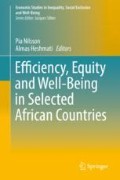Abstract
This study examines the extent of poverty in different provinces and districts in Rwanda using both consumption and income per capita. It also looks at the determinants of household poverty and focuses on four categories for studying the determinants of poverty in the country. The income-based study of poverty is based on information from the household survey and uses 14,810 observations in 2006, 2009, and 2012, while the consumption-based poverty analysis is based on 7498 observations from 2012 database. The results are found to be very sensitive to the definition of poverty line and use of income or consumption in the analysis of poverty. This study shows that older household heads and female-headed households are more likely to be poor. Also living in rural and semi-urban areas increases the probability of being poor. Asset ownership (having a garden, cash crops, banana trees) decreases the probability of being poor. The findings of this study serve as evidence for policymakers to employ poverty alleviation policies. Increasing investments in physical infrastructure, creating jobs for female-headed households, and improving educational levels of household heads should also be focused on.
Access this chapter
Tax calculation will be finalised at checkout
Purchases are for personal use only
References
Asadullah, M. N., & Chaudhury, N. (2012). Subjective well-being and relative poverty in rural Bangladesh. Journal of Economic Psychology, 33, 940–950.
Assefa, M. (2003). Female-headed households and poverty in urban Ethiopia, MSc Thesis, Addis Ababa University.
Bigsten, A., Bereket, K., Abebe, S., & Mokonnen, T. (2002), Growth and poverty reduction in Ethiopia: evidence form household panel surveys. Working Papers in Economics No. 65, Department of Economics, Gothenburg University.
Christiaensen, L., & Subbarao, K. (2001). Towards an understanding of vulnerability in rural Kenya. Unpublished research.
Dzanku, F. M., Jirstrom, M., & Marstrop, H. (2015). Yield gap-based poverty gaps in rural Sub-Saharan Africa. World Development, 67, 336–362.
Fistum, T. (2002). Poverty in Addis Ababa: A comparison of female and male headed households. MSc Thesis, Addis Ababa University, (Unpublished).
Foster, J., Greer, J., & Thorbecke, E. (1984). A class of decomposable poverty measures. Econometrica, 52(3), 761–765.
Gebru, M. (2010). Consumption base measures and analysis of urban poverty: the case of Maichew, Southern Tigray. MSc Thesis, Mekelle University.
Gujarati, D. (1995). Basic Econometrics (International Editions, 3rd ed.). Boston: McGraw-Hill.
Grobler, W. C. J. (2016). Perceptions of poverty: A study of food secure and food insecure households in an urban area in South Africa. Procedia Economics and Finance, 35, 224–231.
HDR (2013). The rise of the South: Human progress in diverse world, explanatory note on 2013 HDR composite indices, Rwanda.
Joo, M. (2011). Effects of federal programs on children: Absolute poverty, relative poverty, and income inequality. Children and Youth Services Review, 33, 1203–1211.
Menon, J., Vijayakumar, N., Joseph, J. K., David, P. C., Menon, M. N., Mukundan, S., Dorphy, P. D., & Banerjee, A. (2015). Below the poverty line and non-communicable diseases in Kerala: The epidemiology of non-communicable diseases in rural areas (ENDIRA) study. International Journal of Cardiology, 187, 519–524.
World Bank Institute (WBI). (2005). Introduction to poverty analysis. Poverty Manual, All, JH Revision of August 8, 2005. Chapter 4. Measures of Poverty, pp. 69–82.
Rashidghalam, M. (2017). Analysis of poverty and its determinants in Rwanda. In A. Heshmati (Ed.), Economic transformation for poverty reduction in Africa (pp. 104–120). Routledge.
Ravallion, M. (1992). Poverty comparisons, a guide to concepts and methods. LSMS WP No.88. Washington D.C: The World Bank.
Statistical, Economic and Social Research and Training Centre for Islamic Countries (SESRTCIC). (2007). Poverty in Sub-Saharan Africa: The Situation in the OIC Member Countries. Available at: http://www.sesrtcic.org.
Ucal, M. Ş. (2014). Panel data analysis of foreign direct investment and poverty from the perspective of developing countries. Procedia Social and Behavioral Sciences, 109, 1101–1105.
White, H., & Kellick, T. (2001). African poverty at the millennium: causes, complexities and challenges. Washington, DC: The World Bank.
Vaaltein, S., & Schiller, U. (2014). Addressing multi-dimensional child poverty: The experiences of caregivers in the Eastern Cape. South Africa. Children and Youth Services Review, 76, 227–236.
Author information
Authors and Affiliations
Corresponding author
Editor information
Editors and Affiliations
Rights and permissions
Copyright information
© 2019 Springer Nature Switzerland AG
About this chapter
Cite this chapter
Heshmati, A., Rashidghalam, M. (2019). Measurement and Analysis of Poverty in Rwanda. In: Nilsson, P., Heshmati, A. (eds) Efficiency, Equity and Well-Being in Selected African Countries. Economic Studies in Inequality, Social Exclusion and Well-Being. Springer, Cham. https://doi.org/10.1007/978-3-030-11419-0_2
Download citation
DOI: https://doi.org/10.1007/978-3-030-11419-0_2
Published:
Publisher Name: Springer, Cham
Print ISBN: 978-3-030-11418-3
Online ISBN: 978-3-030-11419-0
eBook Packages: Economics and FinanceEconomics and Finance (R0)

